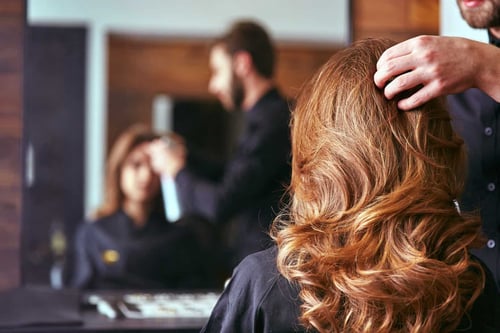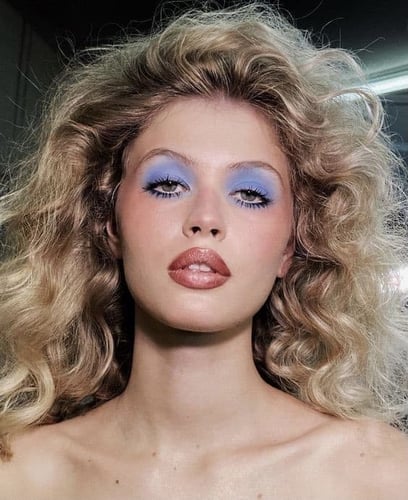People in the 80s were all about self-expression, freedom seekers, and rebellion. This era’s fashion and beauty trends matched the mission of the time.
Individuals embraced bright eye shadow colors, big funky jewelry, and heavily padded structured silhouettes. When it came to hair, two things defined it: layers and volume.
It was all about having big, bold, and beautiful hair. Joan Jett loved rockstar shag, while musicians like Whitney Houston preferred fluffy spiral curls.
Madonna loved to wear bright golden blonde hair with vintage curls, and other celebrities like Heather Locklear rocked with big, beautiful hair.
The more volume the hair was, the better. Stars like Priscilla Presley and Sarah Jessica Parker embraced sky-high volume. So, people with naturally curly hair were at an advantage. Even those with flat and fine hair could also achieve this look. The secret was using a leave-in conditioner to maintain the texture and fluff of the hair.
As with other beauty and fashion trends, the 80s hairstyles have returned bigger and better than before. So it means that the 2020s will see a rise in popularity of the 80s hairstyles.
Want to try the big 80s hair but don’t know where to begin? Keep reading this article to learn more.

Key Takeaway
- 80s hairstyles focused on big, bold, volume and texture – from rockstar shags to spiral curls and sky-high teased styles. These sought-after looks are back.
- Achieving an 80s style begins with determining your natural hair type and texture to select suitable products and caring techniques. Tips are provided for various hair types.
- Key styling techniques involve sectioning, backcombing, and teasing to boost volume as well as using perms and crimping irons to get authentic 80s shapes and patterns.
- Setting styles requires the right hold products while completing the 80s look means pairing statement hair with neon bright colors and accessories.
Determining Your Natural Hair Type and Texture
Hair products and caring styles are developed to suit different types of hair. Knowing your hair type will help you identify the best way to care for it. You can do that by analyzing your curly. Overall, there are four main types of hair:
- Straight: hair strands go straight up and down
- Wavy: strands curve or form an S-shape
- Curly: strands cluster together, winding around to form a spiral or loose curls. You will need to moisturize this hair regularly to encourage the pattern, but some frizz can add to its personality.
- Coily: each hair strand forms tight coils. While it is a versatile hair type, it can be fragile, especially with fine strands, as the external layer may be thin.
Now that you know the different hair types, the next task is determining which one you have.
Various systems are used to categorize hair; one is The Andre Walker Hair Typing system, which can help you identify your hair texture and find the right products.
This classification system classifies hair types into four groups:
Type 1:
This is straight hair and is said to have the most sheen and resilience of all types. It has a fine and fragile texture that’s very difficult to curl. The sebum spreads from the scalp to the ends easily, and curls and kinks don’t interfere with its path, making it the oiliest hair that exists. There are three categories here:
- 1A is a very straight hair with zero waves and curls. This hair is oil and needs frequent shampooing. It is only common in the Asian community.
- 1B is straighter and thicker than 1A, with more volume and bounce. It holds curls better, resulting in more texture and movement.
- 1C straight, coarse, and thicker hair can lead to frizzy hair. When air-dried, it can give a full tousled look.
Type 2:
The second type is wavy hair, which varies in texture. It can be frizzy and thick hair or thin hair. There are three categories here:
- 2A has S-shaped waves and is not that defined or high in volume.
- 2B hair features defined waves that become tighter as they approach the tip.
- 2C which has more volume and well-defined S waves.
Type 3:
It represents curly hair, which ranges from loose to corkscrew curls. The categories are:
- 3A features a loose curl pattern. The hair is fine and shiny.
- 3B hair texture is tighter, thicker, and has more volume
- 3C or c curls are thick and tight and have lots of texture.
Type 4:
Features afro or kinky hair. It includes spiral curls with Z-shaped edges. There are three categories:
- 4A coils are tight and springs. When dry, the strands shrink to half of the hair’s length.
- 4B curls are tight and form Z-shaped coils or crimpy patterns.
- 4C hair type is densely packed and has a tight pattern in an O shape. The hair shrinks so much when wet.
The best way to determine your hair type is by accessing your natural waves and shapes and comparing them to the different types above.
Tips for Wavy Hair (Natural Waves)
Determine whether you have Type 2A, 2B, or 2C by using the explanation above. Then, choose the right products for each type.
- 2A loose waves begin from the eye level to the ends. Don’t flatten, but define the waves. Use gels and avoid creams/oil-based hair products.
- 2B highlights the curls with balayage. You can think of dying the hair strands where the s pattern is.
- 2C, since the hair is frizzy, remember to use a diffuser when blow drying to avoid more frizz.
Also, add lightweight, silicone, and sulfate-free shampoo and other products to your hair care routine, and use silk pillowcases, hairbands, and scrunchies. That said, here are some tips to strengthen wavy hair strands:
- Use warm water and rinse with cold water after shampooing and conditioning
- Hydrate as often as you can
- Deep condition at least once a week
- Use a texturizer on damp or dry hair
Tips for Curly Hair (Coily Hair)

Type 3A: Avoid brushing your hair harshly to retain the color. Often, wear a loose ponytail.
3B: use more moisturizing ingredients like coconut oil, shea butter, and aloe vera. Also, opt for silicone and sulfate-free shampoo and other products to retain moisture.
3C: untangle your hair using a leave-in conditioner since this type often experiences breakage.
If you have coily or kinky hair:
- Moisturize it regularly
- Use deep conditioners, creams, and butter instead of oils
- Do not do tight braids
- Apply leave-in conditioner when on damp hair and comb gently to separate the sections out.
- Keep the coils intact using hair gel or a curling cream
- Opt for shea butter creams and products that moisturize your hair
- Don’t brush your hair harshly
Tips for Straight Hair (Naturally Straight Hair)
Maintaining and styling straight hair is easy if you are using the best products and the right techniques. If you want to add volume to your straight hair, here are some tips:
- Use volumizing shampoos and conditioners
- Avoid conditioning your roots to get them a good foundation for volume. Also, remember to tease them.
- Massage your scalp regularly
- Blow dry upside down
- Opt for a dry shampoo that absorbs excess oil and lifts your roots
- Embrace overnight waves. Divide your hair into sections and plait it. Then, use a non-snag hairband to secure it.
Choosing the right products for straight hair
If you have straight hair, your priority should be to build volume. We’ve already mentioned about using a volumizing shampoo. You must also rinse your hair thoroughly after washing to ensure no shampoo residue is left behind, as it can weigh down your hair.
Also, choose products that match your scalp. For instance, people with oily scalps should opt for shampoo for oily hair and weightless conditioners. At the same time, those with dry hair would do best with moisturizing shampoo.
Additionally, consider your hair’s porosity. If you have high porosity, your hair absorbs products quickly, forcing you to often reapply. In that case, opt for slightly acidic products on the PH scale. If you have low porosity, opt for deep cleansing shampoos and peeling to help open your cuticle and allow better absorption.
You can also get an ’80s perm for a temporary style. Hair perms are back to tending, and people are now incorporating modern styles into the 80s curls. Perms can help add volume, and you can straighten the waves whenever you need a change of style.
How to Prep Hair Before Styling (Wet Hair)
Your hair is more vulnerable when it is wet. If you pull at knots when it’s wet, your hair strands can easily break leaving your hair looking frizzy and limp. It’s best to use a brush and gently comb it to smooth each strand out and allow easier styling. Use these tips to prepare your hair before styling: Here are some washing and conditioning tips:
- Soak your hair in warm water for some minutes.
- Shampoo starts from the roots.
- Scrub the scalp, not the hair.
- Rinse thoroughly and repeat the washing as much as you want.
Apply conditioner focusing on the ends and rinse thoroughly. A leave-in conditioner is advisable, especially for dry hair, as it adds moisture and hydrates the hair shaft. Some products have emollients and humectants which work together to reduce brittleness.
Remove as much of the excess moisture as possible. Moisture overload can make your hair feel limp and mushy, and your curls may struggle to hold shape.
Best 80s Styling Techniques

As mentioned, the 80s hairstyles mainly focused on volume. The more volume the hair had, the better. One of the ways they achieved this was by sectioning. Here is how to use sectioning to add volume:
- Divide your hair into section
- Push your hair gently from the middle towards the root with a comb
- This creates a natural volume without tangles. But make sure you go slowly and repeat each section several times.
Another common technique involves using crimping irons to get the 80s-esque zig-zag pattern. Crimped hair is simple deep waves in small zig zag-shaped kinks created with a hot special tool. It is an ideal hairstyle to control frizz and wild little top hair, especially during the summer. The kinks also help control the volume resulting from humidity.
You can also check out our recent blog about Y2K hairstyles.
Teasing and Backcombing Tips
Teasing/backcombing is combing your hair backward. The back-and-forth motion helps build volume while creating teases or clusters, helping you achieve a thicker look. You can backcomb your ends, roots, or anywhere you want extra fullness and lift. Here are some tips for you:
- Use the right tools, i.e., a double-ended brush with bristles
- Ensure your hair has a suitable texture. Preferably a day or two old to give it residue grit and texture to withstand the volume.
- Divide your hair into manageable sections when backcombing
- Use the right technique to backcomb. Brush out the sections to ensure they are smooth and tangle-free, then hold the section high using your brush and push the hair towards the scalp down to your root using short strokes.
- Maintain the same brushing movements. Remember to finish with a hairspray like Aqua Net Extra Super Hairspray that gives your hair body and volume.
Setting the Style
While big 80s styles are cute, the volume can be difficult to maintain, but you can wear these styles comfortably with the right hair care products and techniques. You may have as many or as few products as you wish. But please remember to include lightweight mousses to give hold and definition to your strands while protecting your hair.
Also, whether you are rocking tight coils or b curls or want a bit of wave on your head, finish your style with a quality hairspray. That will ensure that your style lasts longer and add volume and hold to your hair.
Achieving the Total 80s Glam Look

Source: thequalityedit.com
If you want to rock the total 80s look, you must do more than your hair. Your clothes, makeup, jewelry, and other accessories should reflect this style. Here are some tips for those who want a fuller look.
Pair your voluminous hair with the 80s fashion statement. Usually, individuals went for big tutus, legwarmers, and off-shoulder tops. Neon colors and cut-off sweatshirts were also popular.
When choosing your accessories, opt for sweatbands, clips, and neon accessories that give a total 80s vibe.
For makeup, choose bright eyeshadows like electric blue, bright blush, and glossy lips. Then, rock your hair in a piggy perm or with spiral natural curls.
